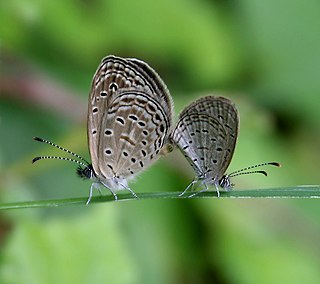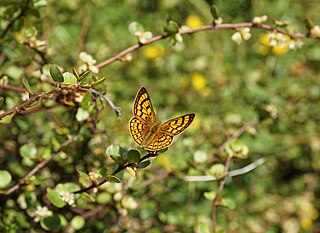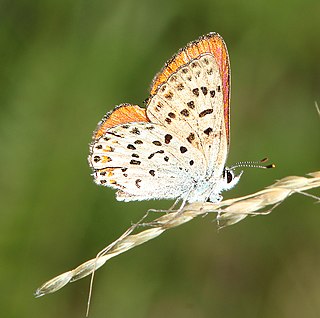
Lycaenidae is the second-largest family of butterflies, with over 6,000 species worldwide, whose members are also called gossamer-winged butterflies. They constitute about 30% of the known butterfly species.

Lycaena phlaeas, the small copper, American copper, or common copper, is a butterfly of the Lycaenids or gossamer-winged butterfly family. According to Guppy and Shepard (2001), its specific name phlaeas is said to be derived either from the Greek φλέγω (phlégo), "to burn up", or from the Latin floreo, "to flourish".

Lycaena is a genus of butterflies. The genus range is Holarctic, with the exception of four species found in New Zealand, two in South Africa, one in New Guinea and one in Java. It is commonly divided into several subgenera, such as Antipodolycaena. Many formerly independent genera are now subsumed within Lycaena; the genus Gaiedes may also belong here. Many of the subgenera, species groups and species listed here may be synonyms.

Zizula, commonly called grass blues, is a genus of butterflies in the family Lycaenidae.

Lycaena salustius, the common copper or the coastal copper, is a butterfly of the family Lycaenidae. It is endemic to New Zealand. It is known in the Māori language as pepe para riki, a name that is shared with a few other members of the genus Lycaena native to New Zealand.

Lycaena edna, or Maui's copper, is a butterfly of the family Lycaenidae. It is endemic to New Zealand. It is known in the Māori language as pepe para riki, a name that is shared with a few other members of the genus Lycaena native to New Zealand, including the closely related coastal copper.
The name Papilio arcas has been applied by authors to several different species of butterfly:

Lycaena boldenarum, the boulder copper, is a species of butterfly which is endemic to New Zealand, it is found on both North Island and South Island in a wide variety of open habitats including grassland, shingle and sand dunes. They are normally only active in bright sunny conditions and their flight is usually low to the ground. The boldenarum part of the species name given by the Scottish entomologist Adam White in honour of his first wife, Helen and her sister Frances, whose maiden name was Bolden. It shares the Maori name pepe para riki with two congeners the common copper and the glade copper.

Lycaena rauparaha, Rauparaha's copper, Fereday’s copper or mokarakare is a species of butterfly endemic to New Zealand. It acquired its English common name because it occurred in the same coastal areas as the rangatira (chief) and war leader of Ngāti Toa Maori, Te Rauparaha.

Lycaena gorgon, known generally as the gorgon copper or stream water-crowfoot, is a species of copper in the butterfly family Lycaenidae. It is found in North America, mainly in California.

Lycaena tama, the Canterbury alpine boulder copper, is a species of copper which lives on the central South Island of New Zealand.









